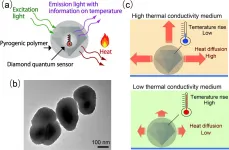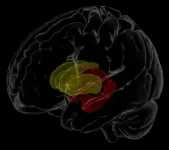(Press-News.org) Exactly what kills a person with COVID-19?
How do those deaths differ from the deaths of people whose lungs fail rapidly because of other infections or injuries?
And what can hospital teams pressed into service on overtaxed COVID-19 wards do to try to keep patients from dying, despite strained circumstances?
All of these questions have sparked discussion - and even conspiracy theories - since the pandemic began. Now, two studies from Michigan Medicine may help answer them.
The bottom line: COVID-19 deaths are indeed different from other lung failure deaths. But, the researchers conclude, the kind of care needed to help sustain people through the worst cases of all forms of lung failure is highly similar. It just needs to be fine-tuned to focus on the damage COVID-19 does to the lungs.
Both studies rely on a standardized in-depth examination of medical records of people who died at Michigan Medicine, the University of Michigan's academic medical center. For each death, the researchers determined which organ system dysfunction most directly resulted in the person's death, or the decision to remove the patient from life support.
In 82 people with COVID-19 who died in the spring and early summer of 2020, that examination of records found that 56% died primarily from the failure of their lungs.
That means they died due to the damage caused by the coronavirus, even if they had other problems and complications of COVID-19 at the time of death. The findings are published in the Annals of the American Thoracic Society.
That's more than twice the rate that researchers saw in the other study, which is based on more than 380 people with similarly severe lung failure who died at the same hospital in years before COVID-19 arose.
In that study, published last summer in Critical Care (DOI:10.1186/s13054-020-03108-w), only 22% of people with lung failure died because of the damage and dysfunction in their lungs.
In both groups, sepsis was the primary cause of death for 26% of patients - which shows the importance of preventing and treating this complication that can arise from an infection and shut down organs throughout the body. Sepsis was the leading cause of death in the non-COVID group, with lung dysfunction and brain/nerve dysfunction close behind.
"These findings underscore the importance of trying to deliver evidence-based interventions for respiratory failure in COVID-19 patients as the pandemic continues, especially as professionals who don't normally treat this condition or work in an ICU are pulled into service," says Scott Ketcham, M.D., the internal medicine resident who led both studies. "This means prone positioning, a good working knowledge of mechanical ventilation, appropriate selection of patients to receive heated high flow oxygen, and early recognition and treatment of infection. In other words, following guidelines developed before by those who specialize in treating respiratory failure like acute respiratory distress syndrome and sepsis."
Help for those pulled into COVID-19 critical care
The COVID-19 patients in the new study were treated before evidence emerged about the effects of dexamethasone and remdesivir on progression of severe cases of the disease, says Hallie Prescott, M.D., M.Sc., the associate professor of pulmonary and critical care medicine who is senior author of the paper. Those options have likely increased survival in the time since.
"There was a lot of talk in the beginning of the pandemic that this was new, and that best supportive care principles already used in ICUs didn't hold true," she says. "But increasingly we realized that all the things we've learned in the past 20 years probably will save people with COVID-19, and that the more we learn about it, the more it seems consistent with ARDS in general. Therapies specific to the respiratory component of this disease will almost surely improve survival."
Prescott and her colleagues have offered a number of webinars and online resources to help providers unused to caring for respiratory failure and sepsis. For instance, simply placing patients in the prone position isn't sufficient - it's also important to move them often so that they don't develop sores that can become entry points for secondary infections.
They include the webinars offered by the Mi-COVID19 consortium that is studying and working to improve COVID-19 care in hospitals across Michigan, posts on the Life in the Fastlane blog for emergency and critical care education by Jack Iwashyna, M.D., Ph.D., from U-M and VA Ann Arbor, and a seminar that Prescott and Iwashyna presented through U-M's Institute for Healthcare Policy and Innovation.
Conditions near death
In addition to looking at the cause of death and related medical measures, Ketcham and his colleagues also looked at the support that patients and families received in the last days of the patients' lives.
In both groups, more than two-thirds of patients were on ventilators or other significant respiratory support when they died, and more than three-quarters of patients died after life support was withdrawn.
But among the COVID-19 patients, the study finds that less than a third had an advance directive in place, stating their wishes should they become critically ill or need someone to make medical decisions for them.
During their COVID-19 hospitalization, about 80% of patients had a goals-of-care conversation with providers documented in their record - most often, one that a provider had by telephone with a family member.
Such conversations take into account the patient's current situation, as well as any advance directives or informal discussions with family they might have had before they became ill. They're important for informing later discussions about treatment or withdrawal of life support.
About 80% of patients received a visit from a spiritual care team member during their hospitalization - but of those who were placed on a ventilator, only 10% got to see a spiritual care provider before they were intubated, when they would have been able to interact more fully.
Ketcham notes that in the first months of the pandemic especially, but even in the months since, the ability of friends and family to connect in person or virtually with critically ill COVID-19 patients has been severely limited across the country. And even when hospital policies have allowed in-person visits, such as at the end of life at Michigan Medicine, family members haven't always wanted to come in person out of fear for their own health.
As a result, only one-third of the patients in the study had family or friends with them when they died, and 55% had neither a virtual visit with friends or family within 24 hours of their death, nor anyone but their care team present when they died.
"The medical therapies we use to treat COVID-19 patients are important, but it's also important to remember to care for, not just treat, these patients," says Ketcham. "We need to think about the individual as a whole, emotionally, spiritually and socially. We need to look at what we gain from visitation policies in terms of transmission, and how we can use technology to connect providers to families, and patients to families and friends."
INFORMATION:
Scientists have uncovered new clues implicating a type of herpes virus as the cause of a central nervous system disease in monkeys that's similar to multiple sclerosis in people.
The findings, published in the Annals of Clinical and Translational Neurology, expand on previous work to understand the cause of the disease and potentially develop antiviral therapies. The work was led by scientists at Oregon Health & Science University.
"This gives us a better understanding of the model," said Scott Wong, Ph.D., senior author of the study and a scientist at the OHSU Vaccine and Gene Therapy Institute and the Oregon National Primate Research Center. "It draws more parallels to MS in people."
The new study reveals the presence of two kinds of T cells, a type of ...
In groundbreaking materials research, a team led by University of Minnesota Professor K. Andre Mkhoyan has made a discovery that blends the best of two sought-after qualities for touchscreens and smart windows--transparency and conductivity.
The researchers are the first to observe metallic lines in a perovskite crystal. Perovskites abound in the Earth's center, and barium stannate (BaSnO3) is one such crystal. However, it has not been studied extensively for metallic properties because of the prevalence of more conductive materials on the planet like metals or semiconductors. The ...
Osaka, Japan - A team of scientists from Osaka University, The University of Queensland, and the National University of Singapore's Faculty of Engineering used tiny nanodiamonds coated with a heat-releasing polymer to probe the thermal properties of cells. When irradiated with light from a laser, the sensors acted both as heaters and thermometers, allowing the thermal conductivity of the interior of a cell to be calculated. This work may lead to a new set of heat-based treatments for killing bacteria or cancer cells.
Even though the cell is the fundamental unit of all living organisms, some physical properties have remained difficult to study in vivo. For example, a cell's thermal conductivity, as well as the rate that heat can flow through an object if ...
Berkeley -- Most frogs emit a characteristic croak to attract the attention of a potential mate. But a few frog species that call near loud streams -- where the noise may obscure those crucial love songs -- add to their calls by visually showing off with the flap of a hand, a wave of a foot or a bob of the head. Frogs who "dance" near rushing streams have been documented in the rainforests of India, Borneo, Brazil and, now, Ecuador.
Conservation ecologist Rebecca Brunner, a Ph.D. candidate at the University of California, Berkeley, has discovered that the glass frog ...
Plant pathologists working at universities across 26 corn-producing states in the United States and in Ontario, Canada, compiled data about annual corn reductions caused by diseases. Estimated loss from each disease varied greatly by region.
"This group of plant pathologists takes a step back to estimate what has gone wrong in corn fields in each of their states," said Iowa State University plant pathologist Daren Mueller, who was involved in this project. "Collectively, and across years, corn disease loss estimates provide folks a zoomed out view of what diseases are affecting corn in the U.S. and Canada."
To Mueller, these data represent one of the pieces of a good research project. Researchers can use these data to justify new research projects that can help mitigate the impacts ...
The U.S. fishing and seafood sector generated more than $200 billion in annual sales and supported 1.7 million jobs in recent years. It experienced broad declines in 2020 as a result of the COVID-19 public health crisis, according to a new NOAA Fisheries analysis released today. While losses vary by sector, by region and by industry, data and information from this report may help businesses and communities assess losses and inform long-term recovery and resilience strategies.
According to analysts, COVID-19 protective measures instituted in March across the United States and globe contributed to an almost-immediate impact on seafood sector sales. There was a strong start to the year, with ...
Like a person breaking up a cat fight, the role of catalysts in a chemical reaction is to hurry up the process - and come out of it intact. And, just as not every house in a neighborhood has someone willing to intervene in such a battle, not every part of a catalyst participates in the reaction. But what if one could convince the unengaged parts of a catalyst to get involved? Chemical reactions could occur faster or more efficiently.
Stanford University material scientists led by Jennifer Dionne have done just that by using light and advanced fabrication and characterization techniques to endow catalysts with new abilities.
In a proof-of-concept experiment, rods of palladium that were approximately 1/200th the width of a human hair served as catalysts. ...
COLUMBIA, Mo. - When he was in middle school, teachers would give Sam Curran a list of words to type in a computer to practice his vocabulary. But Sam, who has autism, was unable to stay focused on the task and required a significant amount of one-to-one direction from a teacher to complete his work. After his mother, Alicia, persuaded his teachers to allow Sam to change the colors of the words, he was able to complete work more independently and began making remarkable progress.
Now 20 years old, Sam's mother continues to ensure his special interests are leveraged in an effort to continue to help him grow and develop. A new survey from the MU Thompson Center for Autism and Neurodevelopmental Disorders has found that similar strategies for children with disabilities can help reduce anxiety ...
A new Northwestern University-led study is unfolding the mystery of how RNA molecules fold themselves to fit inside cells and perform specific functions. The findings could potentially break down a barrier to understanding and developing treatments for RNA-related diseases, including spinal muscular atrophy and perhaps even the novel coronavirus.
"RNA folding is a dynamic process that is fundamental for life," said Northwestern's Julius B. Lucks, who led the study. "RNA is a really important piece of diagnostic and therapeutic design. The more we know about RNA folding and complexities, the better we can design treatments."
Using data from RNA-folding experiments, the researchers generated the first-ever data-driven movies of how RNA folds as it is made by cellular ...
Nearly 38 million people around the world are living with HIV, which, with access to treatment, has become a lifelong chronic condition. Understanding how infection changes the brain, especially in the context of aging, is increasingly important for improving both treatment and quality of life.
In January, researchers at the Mark and Mary Stevens Neuroimaging and Informatics Institute (USC Stevens INI), part of the Keck School of Medicine of USC, and other international NeuroHIV researchers, published one of the largest-ever neuroimaging studies of HIV. The researchers pooled magnetic resonance imaging (MRI) data from 1,203 HIV-positive individuals across Africa, ...





